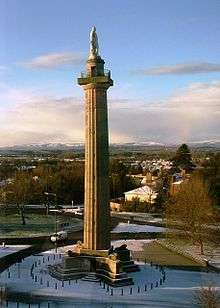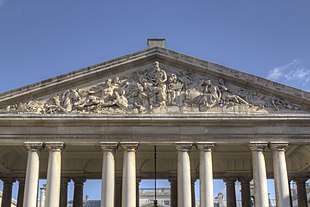Joseph Panzetta
Joseph Panzetta was an Italian sculptor and modeller who worked in England from c.1787-1830 and exhibited at Royal Academy from 1789-1810. He worked for Mrs Eleanor Coade at her Coade Ornamental Stone Manufactory for over 26 years and modelled in Lithodipyra (Coade stone). His finest and most significant works include: the Admiral Lord Nelson's Pediment at the Royal Naval College, Greenwich; and the 5.2 metre statue of Lord Rowland Hill, 1st Viscount Hill, in Shrewsbury that stands atop Lord Hill's Column, the tallest Doric column in Great Britain.
Career
An article in Dictionary of British Sculptors 1660–1851 records: “Panzetta , Joseph, active from c.1787-1830. Exhibited at Royal Academy from 1789-1810. Worked for Mrs Coade over 26 years. ”[1]
Works
Nelson's Pediment - Royal Naval College
Admiral Lord Nelson's Pediment in the King William Courtyard of the Old Royal Naval College, Greenwich - was regarded by the Coade workers as the finest of all their work. It was sculpted by Joseph Panzetta in 1813, as a public memorial after his death at the Battle of Trafalgar in 1805. It was based on a painting by Benjamin West depicting Nelson's body being offered to Britannia by a Winged Victory. The cost of the work at Greenwich, which included many figures, was £2,584.[2][1]
The pediment pictured bears the inscription "Designed by Benjamin West MDCCCXII" (1812).

Lord Hill's Column, Shrewsbury
Lord Hill's Column, outside the Shropshire Council headquarters, is one of the most notable landmarks of the town of Shrewsbury, Shropshire, England. It was modelled by Joseph Panzetta.[1]
In an article in the Dictionary of National Biography (2008) Alison Kelly implies that the statue of Lord Hill in Shrewsbury, at 16 feet tall was circa the largest single figure ever ordered in Coade stone. It cost £315, a very considerable sum in 1816.[3][1]
Other works
His works include figures of Nelson, Neptune and Britannia.
The cost of Panzetta’s work, with others, at Buckingham Palace, which involved many figures, was £1,386.[1]
References
- Friends of Lord Hill's column, What is Coade Stone?
- The Landmark Trust, Where to find Coade stone
- Alison Kelly (art historian), "Eleanor Coade", Oxford National Dictionary of Biography
